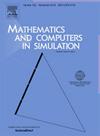Sliding dynamics and codimension-2 bifurcations of an epidemic Filippov system with nonlinear threshold control
IF 4.4
2区 数学
Q1 COMPUTER SCIENCE, INTERDISCIPLINARY APPLICATIONS
引用次数: 0
Abstract
The implementation of preventive and control measures for major infectious diseases is often influenced by a multitude of factors, including the progression of infectious diseases, the current epidemic status, and the population size of various disease states. This paper introduces a threshold control strategy based on a non-smooth Filippov system, wherein the weighted sum of the susceptible population size and its change rate determines whether to enforce vaccination and isolation measures. We investigate the impact of this strategy on the dynamics of infectious disease transmission and analyze the effects of intermittent vaccination and isolation strategies with nonlinear recovery and threshold control functions. Based on the dynamics of subsystems, we analyze the sliding mode and the properties of the sliding regions, as well as the existence of the pseudo-equilibria. Additionally, we analyze the codimension-1 boundary equilibrium bifurcations of the proposed system, including boundary node bifurcation, boundary stable/unstable focus bifurcation, and boundary unstable-stable focus bifurcation. Leveraging the rich codimension-1 boundary equilibrium bifurcations, we explore two types of codimension-2 bifurcations and numerically illustrate the homoclinic boundary focus bifurcation and boundary Hopf bifurcation. Through an in-depth examination of boundary equilibrium bifurcations, we discover that the proposed system displays complex dynamical behaviors under different parameter values, including the emergence of new limit cycles, saddle–node bifurcations and grazing bifurcations of limit cycles. The main results indicate that under a specific control strategy, there exists a threshold value for the weighted sum of the size and change rate of the susceptible population that can effectively control the spread of infectious diseases. Moreover, whether the infected population remains low is contingent on the system’s initial state. Consequently, tailored and comprehensive control strategies must be devised to address the distinct characteristics of different population groups.
一类具有非线性阈值控制的流行病Filippov系统的滑动动力学和余维2分岔
重大传染病防控措施的实施往往受到多种因素的影响,包括传染病的进展、当前的流行状况、各种疾病状态的人口规模等。本文提出了一种基于非光滑Filippov系统的阈值控制策略,其中易感人群大小及其变化率的加权和决定是否实施疫苗接种和隔离措施。我们研究了这种策略对传染病传播动力学的影响,并分析了具有非线性恢复和阈值控制函数的间歇性疫苗接种和隔离策略的效果。基于子系统的动力学,我们分析了系统的滑模和滑模区域的性质,以及伪平衡点的存在性。此外,我们还分析了该系统的共维1边界平衡分岔,包括边界节点分岔、边界稳定/不稳定焦点分岔和边界不稳定-稳定焦点分岔。利用丰富的余维-1边界平衡分岔,探讨了两种类型的余维-2分岔,并数值说明了同斜边界焦点分岔和边界Hopf分岔。通过对边界平衡分岔的深入研究,我们发现系统在不同参数值下表现出复杂的动力学行为,包括新极限环的出现、极限环的鞍节点分岔和放牧分岔。主要结果表明,在特定的控制策略下,易感人群的规模和变化率的加权和存在一个阈值,可以有效控制传染病的传播。此外,感染人数是否保持在低水平取决于系统的初始状态。因此,必须制定有针对性和全面的控制战略,以处理不同人口群体的不同特点。
本文章由计算机程序翻译,如有差异,请以英文原文为准。
求助全文
约1分钟内获得全文
求助全文
来源期刊

Mathematics and Computers in Simulation
数学-计算机:跨学科应用
CiteScore
8.90
自引率
4.30%
发文量
335
审稿时长
54 days
期刊介绍:
The aim of the journal is to provide an international forum for the dissemination of up-to-date information in the fields of the mathematics and computers, in particular (but not exclusively) as they apply to the dynamics of systems, their simulation and scientific computation in general. Published material ranges from short, concise research papers to more general tutorial articles.
Mathematics and Computers in Simulation, published monthly, is the official organ of IMACS, the International Association for Mathematics and Computers in Simulation (Formerly AICA). This Association, founded in 1955 and legally incorporated in 1956 is a member of FIACC (the Five International Associations Coordinating Committee), together with IFIP, IFAV, IFORS and IMEKO.
Topics covered by the journal include mathematical tools in:
•The foundations of systems modelling
•Numerical analysis and the development of algorithms for simulation
They also include considerations about computer hardware for simulation and about special software and compilers.
The journal also publishes articles concerned with specific applications of modelling and simulation in science and engineering, with relevant applied mathematics, the general philosophy of systems simulation, and their impact on disciplinary and interdisciplinary research.
The journal includes a Book Review section -- and a "News on IMACS" section that contains a Calendar of future Conferences/Events and other information about the Association.
 求助内容:
求助内容: 应助结果提醒方式:
应助结果提醒方式:


